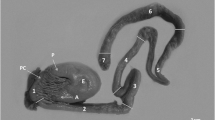Abstract
The juvenile stages and the mature males and females ofPharodes banyulensis parasitize the gill cavity of small brackish water fishes namelyBlennius pavo. Gill tissues are damaged by the hooked anchoring process. The female, during its whole life, is attached on the posterior side of the gill cavity or directly on the gills. A high degree of injury is attributed to the compression of blood vessels; consequently the gill architecture, the internal gill anatomy and the respiratory process are deeply affected. The temporary fixation of juvenile stages and males cause changes. According to our observations, we lesser think that there is a high level of mortality among the young blennies during the first year of their life.
Résumé
Les jeunes stades, les mâles mûrs et les femelles dePharodes banyulensis parasitent la cavité branchiale deBlennius pavo, petit poisson d'eau saumâtre. Les tissus branchiaux sont lésés par la fixation des antennes unciformes. La femelle demeure toute sa vie fixée au niveau de la zone postérieure de la cavité branchiale ou directement sur la branchie. L'obstruction des vaisseaux a de graves répercussions: l'architecture et l'anatomie interne de la branchie ainsi que le processus respiratoire sont affectés. La fixation temporaire des stades jeunes et des mâles est à l'origine de dégats de moindre importance. Nous estimons, d'après nos observations, que le taux de mortalité des jeunes blennies est très élevé durant la première année de leur vie.
Similar content being viewed by others
Abbreviations
- A1 :
-
antennule
- A2 :
-
antenne unciforme
- A.br :
-
arc branchial
- Ax.c :
-
axe branchial cartilagineux
- Br :
-
branchie
- C :
-
coeur
- C.br :
-
cavité branchiale
- Co :
-
collagène
- Ep :
-
épithélium
- Ep.br :
-
epithélium branchial
- L.p :
-
lame primaire=filament
- L.s :
-
lame respiratoire
- M.sq :
-
muscle squelettique
- Mx2 :
-
maxille
- Mxp :
-
maxillipède
- O :
-
oreillette
- P.c.br :
-
paroi postérieure de la cavité branchiale
- P.l :
-
processus latéraux
- sg :
-
sang
- S.g :
-
segment génital
- S. ov :
-
sac ovigère
- St.j :
-
stade juvénile
- T :
-
testicule
- T.d :
-
tube digestif
- T.i :
-
trace d'implantation de la femelle
- T.r :
-
tissu réactionnel
- Ur :
-
uropode
- V :
-
ventricule
Références
Bietrix E (1895) Quelques considérations sur la notion de lacune et d'endothélium en anatomie générale, à propos de réseau vasculaire branchial des poissons. Op Cit 8:26–27, 9:30
Bower-Shore C (1940) An investigation of the common fish louse,Argulus foliaceus (Linn.). Parasitology 32:361–367
Brian A (1940) Sur trois copépodes parasites de poissons des côtes algériennes. Stn. aquicult. pêches 1:11–18
Chabanaud P (1951) Contribution à la morphologie et à la biologie du copépode parasiteDiocus clini. Mém Mus nation Hist nat, A 29:239–330
Ho JS (1970) Revision of the genera of Chondracanthidae, a Copepod family parasitic on marine fishes. Beaufortia 229:105–218
Ho JS (1971)Pharodes Wilson, 1935, a genus of cyclopoid copepods (Pharodidae) parasitic on marine fishes. J nat Hist 5:349–359
Hoar WS, Randall DJ (1970) Fish physiology. Volume IV. The nervous system, circulation, and respiration. Academic Press, New York, San Francisco, London (ed), pp 133–571
Hughes GM, Grimstone AW (1965) The fine structure of the secondary lamellae of the gills ofGadus pollachius. Q J micr Sci 106:343–353
Kabata Z (1970) Diseases of fishes: Crustacea as enemies of fishes. In: Sniesko SF, Axelrod HR (eds), T.F.H. publication, p 1–171
Kabata Z (1979) Parasitic copepoda of british fishes. The Roy Society (ed), pp 1–459
Newstead J (1967) Fine structure of the respiratory lamellae of the teleostean gills. Z Zellforsch 79:396–428
Paperna I, Zwerner DE (1982) Host parasite relationship ofErgasilus labracis Krøyer (Cyclopidea, Ergasilidae) and the striped bass,Morone saxatilis (Walbaum) from the lower Chesepeake bay. Ann Parasitol Hum Comp 57:393–405
Parducz B (1967) Ciliary movement and coordination in ciliates. Intern Rev Cytol 21:91–128
Rousset V, Raibaut A (1983) Intégration de nouveaux caractères structuraux à la systématique des Chondracanthidae (Copepoda, Poecilostomatoida). Soc Zool 108:115–127
Schuurmans Stekhoven JH (1936) Beobachtungen zur Morphologie und Physiologie derLernaeocera branchialis undL. lusci. Z Parasitenkd 8:659–696
Steen JB, Kruysse A (1964) The respiratory function of teleostean gills. Comp Biochem Physiol 12:127–142
Tuzet O, Ormières R (1954) Sur unPharodes (Copépode, Chondracanthidae) parasite deBlennius pavo Risso. Vie Milieu 5:71–73
Vaney C, Conte A (1900) Sur un Chondracanthidae nouveau parasite deClinus argentatus Riss. Rev suisse Zool 8:95–105
Author information
Authors and Affiliations
Rights and permissions
About this article
Cite this article
Rousset, V., Raibaut, A. Conséquences anatomo-fonctionnelles des parasitoses àPharodes banyulensis Delamare Deboutteville, 1951 (Copepoda, Poecilostomatoida, Pharodidae) surBlennius pavo Risso, 1810 (Pisces, Teleostei, Blenniidae) du bassin de Thau (côte méditerranéenne française). Z. Parasitenkd. 70, 119–130 (1984). https://doi.org/10.1007/BF00929581
Accepted:
Issue Date:
DOI: https://doi.org/10.1007/BF00929581




